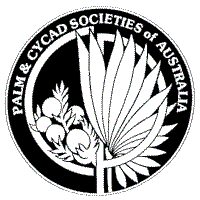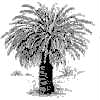|
Palms
The Palms of Hawaii II |

| |||
|
| ||||
Starting from the uninhabited Northwestern island of Island of Nihoa, P. remota thrives with 600 to 700 palms in two forests within the intact dryland ecosystem. No rats or grazing animals have escaped to Nihoa so Pritchardia can be seen in a pristine state. The palm crowns create a thick canopy and the fronds cover the understory of the forest. These spectacular small palms have huge wavy leaves with drooping leaflet tips, extensive, short inflorescences and small fruits (Chapin 1990; Conant 1985). The island is owned by the Federal government and is part of the Hawaiian Islands National Wildlife Refuge .
|
Niiahu, or the forbidden island, is an inhabited, privately owned island,
home of
P. aylmer-robinsonii
. Although only two wild trees are known,
the residents cultivate the palm on Niihau; and it has been brought
into cultivation elsewhere including Botanic Gardens. This medium sized palm
has graceful, lax, green leaves that are somewhat weepy with small,
black fruits.
Kauai, an island about four or five million years older than Hawaii or the "Big Island" has eight Pritchardia palms, including one currently being described. The northern coastal and cliff areas are the habitats for P. napaliensis and P. limahuliensis . Both are endangered, and both are stunning trees. In a mesic (not too dry-not too wet) habitat there are some Pritchardia gems that intermingle or are congeners. P. viscosa has but three trees left in the wild. It is a stunning, spectacular palm with huge, stiff leaves; up to three cupped panicles that clasp over the medium black fruits, and hold them close within the crown. The flowers, branchlets and fruits have a viscous or sticky feel somewhat like a petroleum product; thus the name. Like sentinels, P. waialealeana are majestic, 100 feet tall palms with enormous, symmetrical crowns, flexible green leaves and short inflorescences. These occur in a boggy Metrosideros polymorpha (ohia lehua)- Dicranopteris linearis (uluhe) fern habitat also with plenty of weeds. There is an estimated 300 or so trees but an accurate assessment of their true number is not known. P. hardyi although a medium to short palm has striking inflorescences because they extend well beyond the crown of the tree. Although the upper surfaces of the stiff leaves are green, the undersides are a golden tomentum. The fruits are a medium to small size, turning purplish black when ripe, as do all of the Hawaiian Pritchardia fruit. |
 Figure 1. P. viscosa , one of three remaining trees in the wild (Photo: M.H. Chapin). |
 Figure 2. P. minor within a diverse mesic forest, Kauai (Photo: K.R. Wood). |
The interior and upper elevations of Kauai are where you can discover
P. minor
. I do not know how it got its name as it can grow up to
40 feet in height and the stem is narrow. When climbing even a
twenty-five footer it feels very tall and not "minor" at all.
This charming palm has small, flat leaves, small fruits and the
inflorescence is snug and close within the crown. In one diverse mesic forest
area, there were enough palms to outnumber the rats that eat them and
the ripe fruit can be found on the ground beneath them among the many fronds.
Still, no seedlings or juveniles survive the grazing goats, deer and pigs.
P. flynnii
(in press) is a smaller, stiff leaved palm with
silvery tomentum on the lower surfaces of the leaves and
green smooth upper leaf surfaces. These fragmented populations of
palms occur on steep, open scrubland hillsides and cliffs.
P. perlmanni is a wonderful medium palm that can reach 15 to 30 feet in height. It has leaf blades about three and one-half feet long, which are green above and mostly flat. The leaf stalks are longer than the leaf blades giving them an open crown appearance that is almost scraggly looking. The fruit is small and pear-shaped. It occurs on the outskirts of low-to mid elevation areas and bogs, 377 to 2,790 ft. elevation. This endangered species has 500 individuals in three populations. Oahu is the home of two loulu palms. The robust P. martii has about 10,000 individuals. Yet, it clings to the steep cliffs of the Ko`olau Mountains out of reach. It has stunning stiff leathery leaves and large, round fruits. P. kaalae is another of the few loulu palms where the inflorescence extends well beyond the crown. This attractive palm has large leaves that are thick and the leaflet tips droop. |
On Molokai, three loulu palms are documented. Huelo Islet, an isolated rock that is still free from rats, goats and other grazing animals is the home of P. hillebrandii . Here the bluish leaved loulu can regenerate producing seedlings and juveniles. The trees make up a dense forest, the forest floor covered with fallen fronds. Over 300 trees are known in the wild.
On the main island of Molokai it is another story. P. munroi once thought to only have a single lonely palm left in the world, is now known as two individuals. Yet two palms are still a delicate balance, and are teetering on the brink of extinction. Seeds have been brought into cultivation and used in conservation efforts.
P. lowreyana is a short, robust palm with thick, leathery leaves. It has large black fruits. Although it has 2,000 trees left, that is certainly more than two, but it is not reproducing in the wild and faces threats and endangerment.
Lanai is a dry island with a single palm representative: Pritchardia lanaiensis . This delicate green-leaved palm has drooping leaflet tips that give it an attractive weepy look. It does well in dry habitats.
| <<< Back | Next >>> |
 |
 |
 |
 |
 |
 |
||||